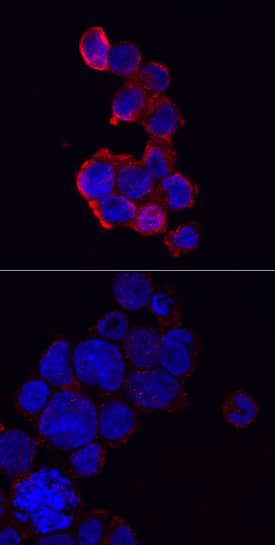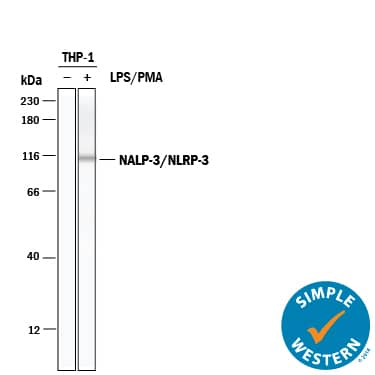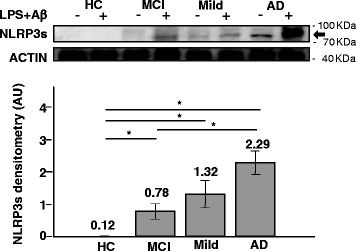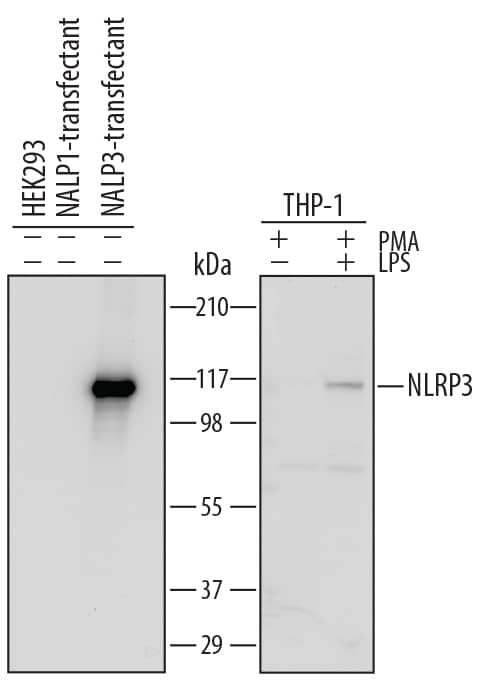Human NLRP3/NALP3 (aa 4-223) Antibody
R&D Systems, part of Bio-Techne | Catalog # AF6789

Key Product Details
Validated by
Species Reactivity
Applications
Label
Antibody Source
Product Specifications
Immunogen
Ala4-Val223
Accession # Q96P20
Specificity
Clonality
Host
Isotype
Scientific Data Images for Human NLRP3/NALP3 (aa 4-223) Antibody
Detection of Human NLRP3/NALP3 by Western Blot.
Western blot shows lysates of HEK293 human embryonic kidney cell line either mock transfected, transfected with human NALP1 or transfected with NLRP3/NALP3 and THP-1 human acute monocytic leukemia cell line untreated (-) or treated (+) with 20 ng/mL PMA for 72 hours and 1 µg/mL LPS for 24 hours. PVDF Membrane was probed with 0.5 µg/mL of Sheep Anti-Human NLRP3/NALP3 Antigen Affinity-purified Polyclonal Antibody (Catalog # AF6789) followed by HRP-conjugated Anti-Sheep IgG Secondary Antibody (Catalog # HAF016). A specific band was detected for NLRP3/NALP3 at approximately 115 kDa (as indicated). This experiment was conducted under reducing conditions and using Immunoblot Buffer Group 2.NLRP3/NALP3 in THP‑1 Human Cell Line.
NLRP3/NALP3 was detected in immersion fixed THP-1 human acute monocytic leukemia cells, unstimulated (lower panel) and stimulated (upper panel) with PMA and LPS, using Sheep Anti-Human NLRP3/NALP3 Antigen Affinity-purified Polyclonal Antibody (Catalog # AF6789) at 10 µg/mL for 3 hours at room temperature. Cells were stained using the NorthernLights™ 557-conjugated Anti-Sheep IgG Secondary Antibody (red; Catalog # NL010) and counterstained with DAPI (blue). Specific staining was localized to cytoplasm. View our protocol for Fluorescent ICC Staining of Non-adherent Cells.Detection of Human NLRP3/NALP3 by Simple WesternTM.
Simple Western lane view shows lysates of THP-1 human acute monocytic leukemia cell line untreated (-) or treated (+) with PMA and LPS, loaded at 0.2 mg/mL. A specific band was detected for NLRP3/NALP3 at approximately 111 kDa (as indicated) using 50 µg/mL of Sheep Anti-Human NLRP3/NALP3 (aa 4-223) Antigen Affinity-purified Polyclonal Antibody (Catalog # AF6789) followed by 1:50 dilution of HRP-conjugated Anti-Sheep IgG Secondary Antibody (Catalog # HAF016). This experiment was conducted under reducing conditions and using the 12-230 kDa separation system.Applications for Human NLRP3/NALP3 (aa 4-223) Antibody
Immunocytochemistry
Sample: Immersion fixed THP-1 human acute monocytic leukemia cell line
Simple Western
Sample: THP‑1 human acute monocytic leukemia cell line treated with PMA and LPS
Western Blot
Sample: HEK293 human embryonic kidney cell line either transfected with human NALP1 or transfected with NALP3 and THP‑1 human acute monocytic leukemia cell line treated with PMA and LPS
Formulation, Preparation, and Storage
Purification
Reconstitution
Formulation
Shipping
Stability & Storage
- 12 months from date of receipt, -20 to -70 °C as supplied.
- 1 month, 2 to 8 °C under sterile conditions after reconstitution.
- 6 months, -20 to -70 °C under sterile conditions after reconstitution.
Background: NLRP3/NALP3
NALP3 (NAcht, Leucine-rich repeat and PYD domain containing protein 3; also PYPAF1, CIAS1 and CLR1.1) is a cytoplasmic 115-130 kDa member of the NLRP family of molecules. It is selectively expressed, being found in stratified squamous and transitional epithelium, Hassell's corpuscles, neutrophils, dendritic cells and T cells. NALP3 promotes IL-1 beta and IL-18 maturation by activating caspase-1. It does so by forming a NALP3 inflammasome comprised of NALP3, ASC and caspase-1. Bacterial RNA and cell wall peptidoglycan can bind to NALP3, promoting (potentially) ATP binding, NALP3 oligomerization, and caspase activation. Human NALP3 is 1036 amino acids (aa) in length. It contains an N-terminal DAPIN domain (aa 1-93), a NACHT domain (aa 220-536), and seven consecutive LRRs (aa 740-991). Alternate splice forms are reported. Either individually, or in combination, there can be deletions of aa 836-892 or 721-777, and a premature truncation after Gly719 that generates a 70 kDa isoform. Over aa 3-223, human NALP3 shares 76% aa identity with mouse NALP3.
Long Name
Alternate Names
Gene Symbol
UniProt
Additional NLRP3/NALP3 Products
Product Documents for Human NLRP3/NALP3 (aa 4-223) Antibody
Product Specific Notices for Human NLRP3/NALP3 (aa 4-223) Antibody
For research use only



